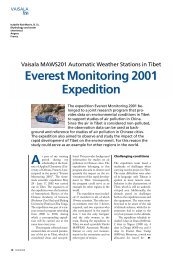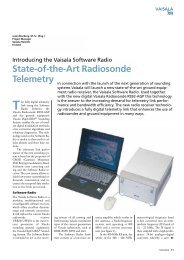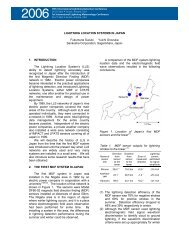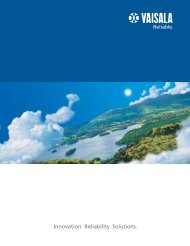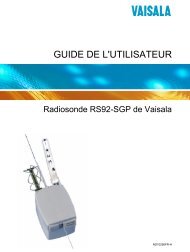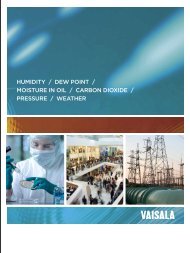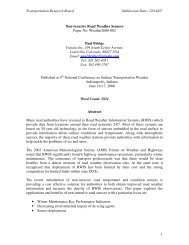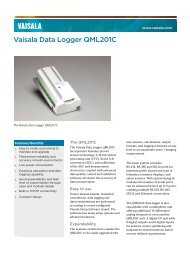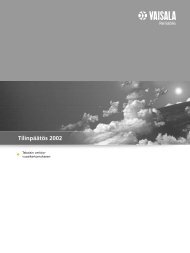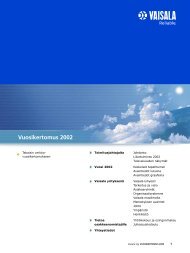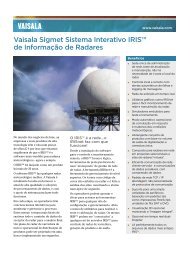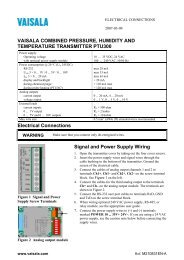humidity / dew point / tempeRAtuRe / moistuRe in oil ... - Vaisala
humidity / dew point / tempeRAtuRe / moistuRe in oil ... - Vaisala
humidity / dew point / tempeRAtuRe / moistuRe in oil ... - Vaisala
Create successful ePaper yourself
Turn your PDF publications into a flip-book with our unique Google optimized e-Paper software.
<strong>Vaisala</strong> Sensor Technologies for W<strong>in</strong>d and Ra<strong>in</strong> Measurements<br />
<strong>Vaisala</strong> WINDCAP® Sensor<br />
<strong>Vaisala</strong> WINDCAP ® Ultrasonic W<strong>in</strong>d Sensor uses ultrasound<br />
to determ<strong>in</strong>e w<strong>in</strong>d speed and direction. The sensor has<br />
no mov<strong>in</strong>g parts, which makes it <strong>in</strong>dependent of the<br />
limitations of mechanical w<strong>in</strong>d sensors such as friction,<br />
<strong>in</strong>ertia, time constant, over-speed<strong>in</strong>g, and start<strong>in</strong>g treshold.<br />
How It Works<br />
WINDCAP ® sensor features an array of three ultrasonic<br />
transducers oriented to form an equilateral triangle. W<strong>in</strong>d<br />
measurement is based on time of flight (TOF) of the sonic<br />
impulse - the time it takes for the signal to travel from one<br />
transducer to another. TOF is measured <strong>in</strong> both directions<br />
for each pair of transducer heads. Simple algebra allows<br />
solv<strong>in</strong>g for the parallel component of w<strong>in</strong>d velocity<br />
<strong>in</strong>dependently of the static speed of sound.<br />
The equilateral triangle configuration of the three<br />
Transducer separation length, L<br />
Transmit<br />
Receive<br />
1<br />
1<br />
Time of flight, t 1<br />
Vw<br />
Parallel component of w<strong>in</strong>d velocity<br />
Time of flight, t 2<br />
For static speed of sound V s:<br />
Comb<strong>in</strong>e to remove V s:<br />
Solve for V<br />
w<br />
V w =<br />
1 =<br />
t 1<br />
V s + V<br />
L<br />
w<br />
L 1<br />
1<br />
2<br />
( - )<br />
t 1<br />
t 2<br />
and<br />
2<br />
2<br />
Receive<br />
Transmit<br />
1 V s + V<br />
=<br />
t 2<br />
L<br />
w<br />
<strong>Vaisala</strong> RAINCAP® Sensor<br />
<strong>Vaisala</strong> RAINCAP ® Sensor is an acoustic sensor that<br />
measures the impact of <strong>in</strong>dividual ra<strong>in</strong>drops on a smooth<br />
sta<strong>in</strong>less steel surface us<strong>in</strong>g a piezoelectric detector. The<br />
sensor provides real time <strong>in</strong>formation on ra<strong>in</strong> <strong>in</strong>tensity,<br />
duration, and accumulated ra<strong>in</strong>fall.<br />
How It Works<br />
The RAINCAP ® sensor consists of a round sta<strong>in</strong>less steel<br />
cover, approximately 90 mm <strong>in</strong> diameter mounted to a<br />
rigid frame. A piezoelectric detector is located beneath<br />
the cover.<br />
Ra<strong>in</strong>drops hit the RAINCAP ® sensor surface at term<strong>in</strong>al<br />
velocity, which is a function of the ra<strong>in</strong>drop diameter.<br />
Ra<strong>in</strong> measurement is based on acoustic detection of each<br />
<strong>in</strong>dividual ra<strong>in</strong> drop as it impacts the sensor cover. Larger<br />
drops create a larger acoustic signal than smaller drops.<br />
The piezoelectric detector converts the acoustic signals<br />
<strong>in</strong>to voltages. Total ra<strong>in</strong> is calculated from the sum of the<br />
<strong>in</strong>dividual voltage signals per unit time and the known<br />
surface area of the RAINCAP ® sensor. In addition, the<br />
<strong>in</strong>tensity and duration of ra<strong>in</strong> can be calculated.<br />
p v = mv t<br />
transducers provides three possible sets of basis vectors.<br />
The comb<strong>in</strong>ations yield bi-directional measurements on<br />
the paths labeled A, B and C. These measurements are<br />
used to determ<strong>in</strong>e the w<strong>in</strong>d velocity components parallel<br />
to each of the three paths.<br />
Electronics<br />
Piezo detector<br />
Algorithm<br />
path a<br />
60˚<br />
1<br />
60˚<br />
path C<br />
60˚<br />
2 3<br />
path b<br />
Basis<br />
set 1<br />
Basis<br />
set 2<br />
Basis<br />
set 3<br />
A<br />
A<br />
B<br />
B<br />
C<br />
C<br />
Output<br />
Pv = vertical momentum<br />
m = mass of drop<br />
v t<br />
= term<strong>in</strong>al velocity of drop<br />
Weather<br />
For more <strong>in</strong>formation, visit<br />
www.vaisala.com or contact<br />
us at sales@vaisala.com<br />
Ref. B211233EN-A ©<strong>Vaisala</strong> 2012<br />
This material is subject to copyright protection, with all copyrights<br />
reta<strong>in</strong>ed by <strong>Vaisala</strong> and its <strong>in</strong>dividual partners. All rights reserved.<br />
Any logos and/or product names are trademarks of <strong>Vaisala</strong> or<br />
its <strong>in</strong>dividual partners. The reproduction, transfer, distribution or<br />
storage of <strong>in</strong>formation conta<strong>in</strong>ed <strong>in</strong> this brochure <strong>in</strong> any form<br />
without the prior written consent of <strong>Vaisala</strong> is strictly prohibited.<br />
All specifications — technical <strong>in</strong>cluded — are subject to change<br />
without notice.<br />
167




